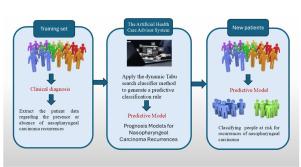基于禁忌搜索算法的鼻咽癌复发预后模型。
IF 3.1
4区 生物学
Q2 BIOLOGY
引用次数: 0
摘要
癌症是一个影响全球的重大公共卫生问题。由于这种疾病,已经观察到大量的死亡率,预计将来会有更多的死亡率。近年来,耳鼻喉科和肿瘤学家对复发性鼻咽癌(NPC)患者的适当治疗方案的发展越来越感兴趣。这些治疗方式的主要目的是延长复发患者的寿命,提高他们的总体生存和生活质量。例如,元启发式算法(meta - heuristic algorithms, MH)是一种软计算技术,由于其有效性,通常用于医疗保健数据。此外,元启发式依赖于进化搜索原理。它们指导搜索过程有效地探索搜索空间,以找到解决全局优化问题的近最优解。禁忌搜索(TS)是一种用于优化问题的方法,属于元启发式技术。该算法的一个重要特点是利用自适应记忆,通过避免局部最优性和提高灵活性来提高搜索效率。另一个例子是数据挖掘,它是人工智能的一个子集,利用数据从以前未知的模式中提取有意义的信息。它已越来越多地用于医疗保健,以帮助临床诊断和疾病预测。所提出的技术将数据挖掘问题视为组合优化问题,并使用元启发式方法解决数据挖掘挑战,例如未知数据的分类和为重要模式找到关联规则。本文提出的禁忌搜索分类器方法(TSCM)主要利用禁忌搜索(TS)算法,并结合动态邻域结构(DNHS)对其进行增强,有助于更好地发现搜索空间。TSCM算法根据患者数据识别出三条规则,并生成三个精确的人工预测模型,以确定和分类有复发鼻咽癌风险的个体。随着治疗的每个阶段,可以访问其他功能。第一个模型依赖于包含描述性数据的主要数据集。第二个模型包含比第一个模型更多的特性,但不包括响应特性。第三个模型利用了所有现有的特征,包括反应特征,这是在治疗阶段结束后三个月观察到的,第三个模型被认为是治疗后监测。本文介绍了一种人工咨询医疗保健系统(AAHS),该系统利用这些模型准确预测治疗期间和治疗后的复发情况,作为治疗后监测。这种预测能够根据系统的产出调整治疗计划和实施额外措施。鉴于人工智能在医学研究中的日益普及,所提出的系统旨在预测某些患者鼻咽癌复发的可能性。因此,这将使肿瘤学家能够采取额外的医疗预防措施来防止复发,并提高他们对癌症的了解。实验结果表明,所提出的三种预测模型均优于现有的鼻咽癌复发预测模型。本文章由计算机程序翻译,如有差异,请以英文原文为准。

Prognosis models for nasopharyngeal carcinoma recurrences by using tabu search algorithm
Cancer is a significant public health issue that has a global impact. Significant mortality rates have already been observed due to this disease, and more mortalities are expected in the future. In recent times, there has been a growing interest among otolaryngologists and oncologists in the development of appropriate treatment regimens for patients with recurrent nasopharyngeal carcinoma (NPC). The primary objective of these treatment modalities is to extend the lifespan of patients following recurrence and enhance their overall survival and quality of life. For instance, metaheuristic algorithms (MH), a form of soft computing technology, are commonly utilized in healthcare data due to their effectiveness. Furthermore, metaheuristics rely on the evolutionary search principle. They direct the search process to effectively explore the search space in order to find near-optimal solutions for solving global optimization problems. Tabu search (TS) is a method used in optimization problems and falls under metaheuristic techniques. An essential element of TS is its utilization of adaptive memory, which enhances search efficiency by avoiding local optimality and promoting flexibility. Another example is data mining, which is a subset of artificial intelligence that utilizes data to extract meaningful information from previously unknown patterns. It has been increasingly used in healthcare to aid clinical diagnostics and disease prediction. The proposed technique treated data mining problems as combinatorial optimization problems and used metaheuristics to address data mining challenges, such as classification for unknown data and finding association rules for significant patterns. The Tabu Search Classifier Method (TSCM) outlined in this paper primarily utilizes the Tabu Search (TS) algorithm, enhanced with the incorporation of Dynamic Neighborhood Structure (DNHS), which contributes to better discovery of the search space. The TSCM algorithm identifies three rules based on the patients’ data and generates three precise artificial predictive models to determine and categorize individuals who are at risk of recurrent NPC. With each stage of the treatment, additional features become accessible. The first model relies on a primary data set that includes descriptive data. The second model incorporates more features than the first model but does not include the response feature. The third model utilizes all existing features and includes the response feature, which is observed three months after the treatment phase concludes, the third model is considered a post-treatment monitoring. This paper introduces an Artificial Advisory Healthcare System (AAHS) that utilizes these models to accurately predict the occurrence of recurrence during each stage of treatment and after the treatment as a post-treatment monitoring. This prediction enables the adjustment of the treatment plan and the implementation of additional measures in accordance with the system’s outputs. Given the growing prevalence of artificial intelligence in medical research, the proposed system aims to predict the likelihood of NPC recurrence in certain patients. Therefore, this will enable oncologists to take additional medical precautions to prevent recurrence and enhance their understanding of cancer. The experimental results indicate that the three proposed predictive models outperform the existing prognoses for NPC recurrence.
求助全文
通过发布文献求助,成功后即可免费获取论文全文。
去求助
来源期刊

Computational Biology and Chemistry
生物-计算机:跨学科应用
CiteScore
6.10
自引率
3.20%
发文量
142
审稿时长
24 days
期刊介绍:
Computational Biology and Chemistry publishes original research papers and review articles in all areas of computational life sciences. High quality research contributions with a major computational component in the areas of nucleic acid and protein sequence research, molecular evolution, molecular genetics (functional genomics and proteomics), theory and practice of either biology-specific or chemical-biology-specific modeling, and structural biology of nucleic acids and proteins are particularly welcome. Exceptionally high quality research work in bioinformatics, systems biology, ecology, computational pharmacology, metabolism, biomedical engineering, epidemiology, and statistical genetics will also be considered.
Given their inherent uncertainty, protein modeling and molecular docking studies should be thoroughly validated. In the absence of experimental results for validation, the use of molecular dynamics simulations along with detailed free energy calculations, for example, should be used as complementary techniques to support the major conclusions. Submissions of premature modeling exercises without additional biological insights will not be considered.
Review articles will generally be commissioned by the editors and should not be submitted to the journal without explicit invitation. However prospective authors are welcome to send a brief (one to three pages) synopsis, which will be evaluated by the editors.
 求助内容:
求助内容: 应助结果提醒方式:
应助结果提醒方式:


